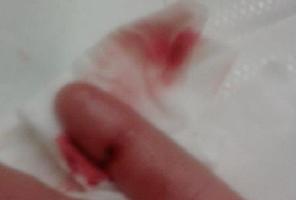
Description
The large intestine (or large bowel) is the last part of the digestive system.
The large intestine consists of the cecum, colon, rectum and anal canal. It starts in the right iliac region of the pelvis, just at or below the right waist, where it is joined to the bottom end of the small intestine. From here it continues up the abdomen, then across the width of the abdominal cavity, and then it turns down, continuing to its endpoint at the anus.
The large intestine is about 4.9 feet (1.5 m) long, which is about one-fifth of the whole length of the intestinal canal.
Function
The large intestine takes about 16 hours to finish the digestion of the food. It removes water and any remaining absorbable nutrients from the food before sending the indigestible matter to the liver. The colon absorbs vitamins which are created by the colonic bacteria - such as vitamin K (especially important as the daily ingestion of vitamin K is not normally enough to maintain adequate blood coagulation), vitamin B12, thiamine and riboflavin. It also compacts faeces, and stores faecal matter in the rectum until it can be discharged via the anus in defecation.
Colour
White.
Shape
Upside down U Shaped, like a thick snake.
Location
Within the abdomen between the small intestines and anus.
Parts of the large intestine are:
The large intestine (or large bowel) is the last part of the digestive system.
The large intestine consists of the cecum, colon, rectum and anal canal. It starts in the right iliac region of the pelvis, just at or below the right waist, where it is joined to the bottom end of the small intestine. From here it continues up the abdomen, then across the width of the abdominal cavity, and then it turns down, continuing to its endpoint at the anus.
The large intestine is about 4.9 feet (1.5 m) long, which is about one-fifth of the whole length of the intestinal canal.
Function
The large intestine takes about 16 hours to finish the digestion of the food. It removes water and any remaining absorbable nutrients from the food before sending the indigestible matter to the liver. The colon absorbs vitamins which are created by the colonic bacteria - such as vitamin K (especially important as the daily ingestion of vitamin K is not normally enough to maintain adequate blood coagulation), vitamin B12, thiamine and riboflavin. It also compacts faeces, and stores faecal matter in the rectum until it can be discharged via the anus in defecation.
Colour
White.
Shape
Upside down U Shaped, like a thick snake.
Location
Within the abdomen between the small intestines and anus.
Parts of the large intestine are:
- Cecum – the first part of the large intestine
- Taeniae coli – three bands of smooth muscle
- Haustra – bulges caused by contraction of taeniae coli
- Epiploic appendages – small fat accumulations on the viscera
- The ascending colon
- The right colic flexure (hepatic)
- The transverse colon
- The transverse mesocolon
- The left colic flexure (splenic)
- The descending colon
- The sigmoid colon – the v-shaped region of the large intestine









 RSS Feed
RSS Feed
